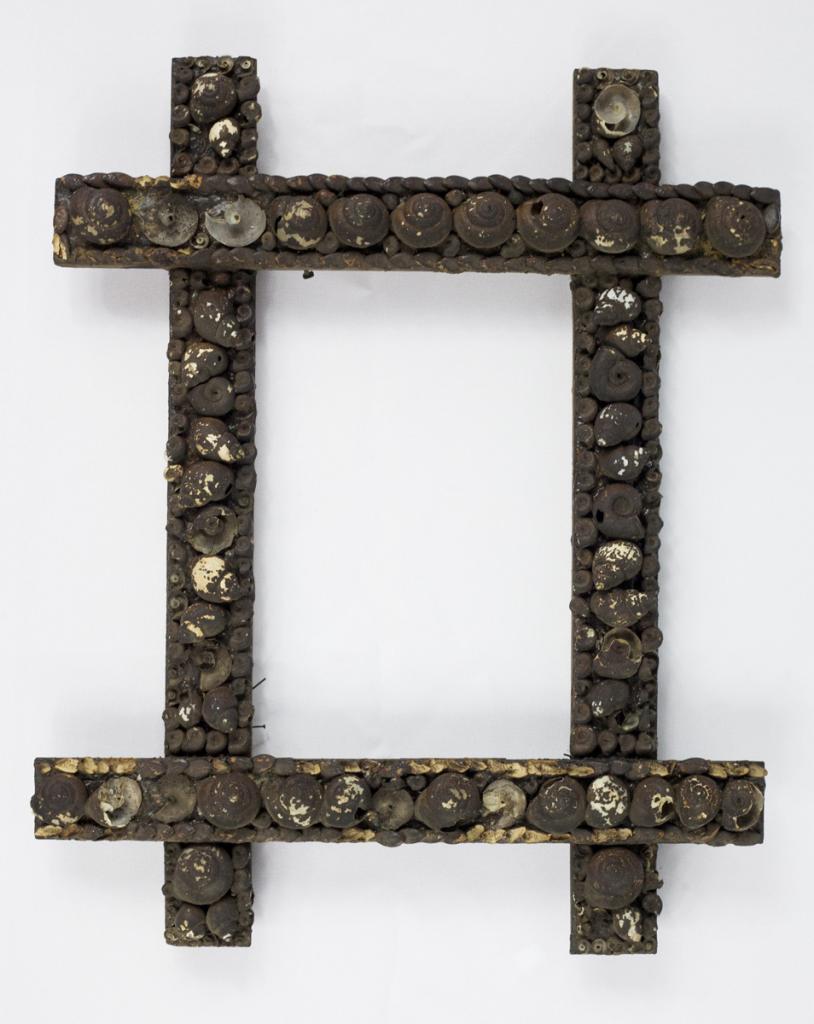Made in America with Foreign Parts
20 Shell Frame
 |
Frame American Attributed to the Donald/Sweet Family, c.1890 Wood, snail shells, seeds Gift of Delma Donald Woodburn Estate MHAHS 2002.001.0067 |
The willow plant stand, basket and ornamental frames are surviving examples of the “make-do” endeavors of rural community members around the turn of the 19th Century. By using local resources, they created unique, artistic home decorations with lasting sentimental value. At the same time, the larger British and American Arts and Crafts movement heralded such artistic production in response to the Industrial Revolution. Making hand-crafted items reinforced a return to more ideal economic times and better moral health of communities. Such sentiments survive in today’s non-professional, Do-It-Yourself culture and professional crafts that market the decorative appeal of rustic furnishings and home adornments.
The residence of the Donald family was an emblematic representation of life in the early 20th century Wisconsin through its many objects and artifacts. These are some of the dozens of artifacts that came to the Mt. Horeb Area Historical Society from the estate of Delma Donald Woodburn (1899-2001), who carefully documented and preserved the material heritage of her family’s life in Mount Horeb and Madison, Wisconsin. The artifacts span several generations, beginning with two early pioneer families who came to the rural Mount Horeb area from New York state in 1855–William Sweet and Sally Clark Sweet and Reverend James Donald and Margaret Strong Donald.
The large collection of objects of Delma Donald Woodburn included many objects of different categories, utensils, clothes, and other artifacts.
By this time, in the 19th century, women’s magazines promoted household craft and decorations. Young ladies were expected to learn domestic skills and even common household goods became a pallet for artistic expression. Parlors and family spaces were filled with this kind of craft, making her home more inviting and following the Victorian magazine arts of the time. Vona Donald chose bucolic rural winter scenes to enhance and decorate her environment. With paint and inspiration, the rural landscapes were one of the frequent motifs that brought character to these daily objects.
Objects such as the butter paddle, the wood panel, the picture frames and the cutlery box are examples of the use of daily artifacts as the folk artist’s canvas. Their work added personality to each object making them unique. Some of those artifacts later became a piece of remembrance of a loving relative.
Besides decorative painting, many other elements were used in these craft projects. Norwegian-American folk art went far beyond rosemaling and acanthus wood carving.
SHELL FRAME
Picture frames are objects often connected to sentimental value and, because of that, they were common in the make-do practice. This frame received peculiar natural elements as ornaments: snail shells and watermelon seeds, materials probably abundant in rural communities, glued to a rectangular wooden structure. Make-do was a vivid activity among Norwegian-American self-taught folk-artists. By adding new elements, the pieces were modified and became unique in character. Until today this habit inspires people around the world with the DIY – Do It Yourself- movement.
Sources
For a history of the Donald and Sweet families, see “Settlement” Friends of Donald County Park (accessed December 9, 2008)
For more information on Delma Donald Woodburn, see “Delma Donald Woodburn” in “Pages of the Past” Mt. Horeb Area Historical Society. Accessed December 9, 2008. http://donaldpark.org/pdf/historyDonaldPark2.pdf
http://www.mounthoreb.org/ppDelma.htm
Wisconsin Decorative Arts Database

